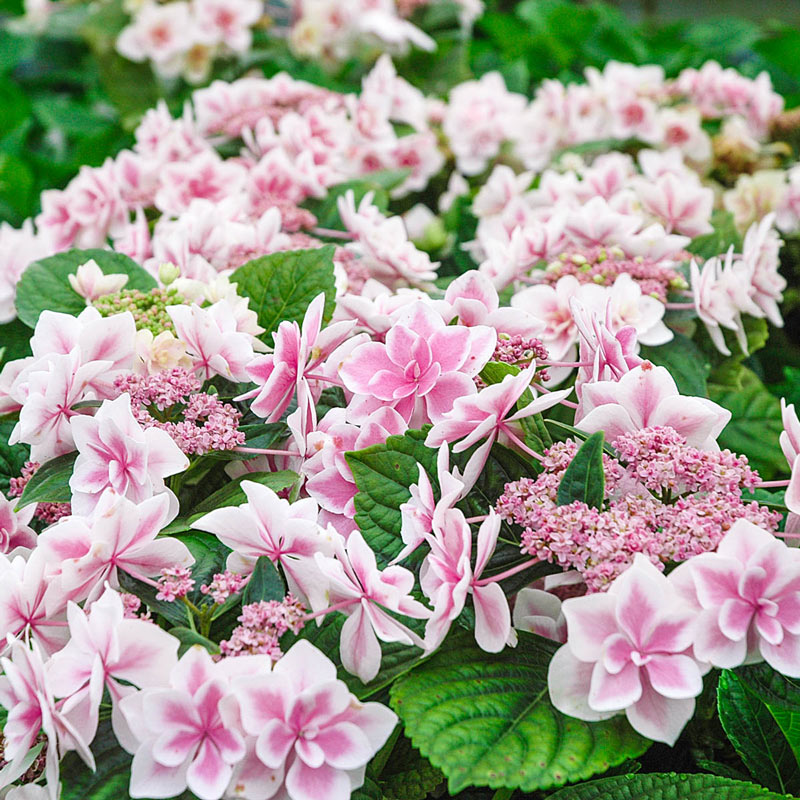

It generally features serrate, obovate to elliptic, dark green leaves (4-8” long) and large clusters of long-blooming summer flowers in either lacecap form (flattened flower clusters of small fertile florets with scattered showy sterile florets often forming a marginal ring) or mophead form (globose flower clusters of mostly showy sterile florets). Louis area, typically grows 3-6’ tall and as wide unless damaged by harsh winters or pruned smaller. Hydrangea macrophylla, commonly called big leaf hydrangea, is a deciduous shrub with a rounded habit that, in the St. Even if old growth buds are damaged in winter, plants should still flower in summer on new growth. Hydrangea macrophylla STAR GAZER blooms on both old and new growth and reportedly has better winter hardiness than many of the other H. Their pruning and flowering can differ from that of the species. Some newer cultivars have been selected that flower on both old and new wood. low temperatures, sudden wide temperature fluctuations, icy conditions, late frosts). Regardless of protective measures taken, most bigleaf hydrangeas simply will not bloom (or will bloom poorly) in some years because of a variety of winter occurrences beyond the control of the gardener (e.g. A burlap wrap of stems or circle of chicken wire filled with leaves or straw to 8-12" are time-consuming and visually unattractive landscape options, but can be effective. For added protection, however, plants grown in USDA Zone 5 should be sited in sheltered locations and given additional winter protection, as needed, for the purposes of minimizing the risk of loss of significant numbers of flower buds or possible die-back to the ground in an extremely harsh winter. Best to mulch plants year-round with 3" of shredded bark, peat or compost. Prune out weak or winter-damaged stems in late winter/early spring. If needed, prune immediately after flowering by cutting back flowering stems to a pair of healthy buds. Begin soil treatments well in advance of flowering, as in late autumn or early spring. Add aluminum sulfate to the soil to make the flowers bluer or add lime to the soil to make the flowers pinker. Soil pH affects the flower color of most cultivars except white (blue in highly acidic soils and lilac to pink in slightly acidic to alkaline soils).
#STAR GAZER HYDRANGEA FULL#
Tolerates full sun only if grown in consistently moist soils.

It’s a bit more price wise but definitely worth the cost, and it grows in zones 6 – 9, a wide range.Best grown in rich, medium moisture, well-drained soils in part shade. For instance, I have mine amidst a shaggy spiraea, purple penstemon, and yellow physocarpus. The leaves are large and textural, offering an excellent architectural structure to contrast with other leaf forms. The flower color glows in afternoon shade, thus brightening the garden. So if you water the heck out of it afterward, you will be successful and the plant’s leaves won’t sag.Ībove is a photo of my perfectly pink hydrangea. If you don’t cut anchor roots, you won’t send it into shock. The fibrous roots spread out like a pancake around the base enabling you to dig them out easily. Because they have a fibrous root system, there are few if any anchor roots. I’ve transplanted large, medium, and small ones. Hydrangeas are some of the easiest shrubs to transplant. It’s inside what I call my hummingbird, bee, and butterfly garden. I solved that by moving it to a spot more in the center of the border. Whenever I turned on the sprinkler system, the sprinkler head popped up and the spray hit the hydrangea, thus blocking water from all other plants. In my records, I recorded it as Double Delights ‘Stargazer’ though it’s so packed with flowers, I’m unsure if it truly is that cultivar.
#STAR GAZER HYDRANGEA HOW TO#
The blooms can be mopheads (round pom-poms), lace cap (flat and wide), or panicle (triangular).īecause there are a million articles on how to care for hydrangeas, I won’t go into that but spotlight the hydrangea I transplanted. With certain amendments to the soil, colors vary from deep burgundy to lavender to icy blue. There are so many species now that you can grow every flower color and shape. I weeded for a while and then transplanted my Stargazer hydrangea, a lovely pink shrub with pointed flowers. This Sunday was sunny and warm, the kind of Sunday where you just want to set up a lounge chair and read a book.


 0 kommentar(er)
0 kommentar(er)
